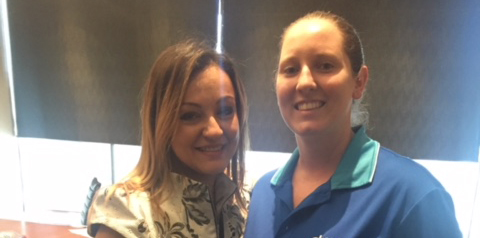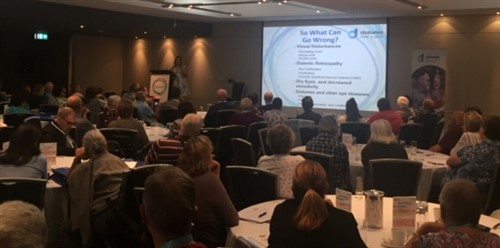1:30min

Optometrist Amira Howari, left, with Diabetes NSW & ACT event co-ordinator Alana Bond at the Penrith Live Your Life Expo.
_____________________________
By Helen Carter
Journalist
Dry eyes and an unstable tear film in patients with diabetes may be a sign of nerve ending damage in the cornea, a potential precursor for peripheral diabetic neuropathy, Sydney optometrist Amira Howari is telling diabetes expos.
In her role as ambassador for Diabetes Australia, Ms Howari, a senior clinical optometrist with type 1 diabetes, regularly speaks at diabetes expos and conferences educating the public.
‘Diabetic retinopathy is not the only eye concern for people with diabetes,’ she tells them.
‘Other structures in the eyes are also affected including the cornea.
‘Many people with diabetes are not aware that dry eye is a possible symptom and complication for other changes occurring on the ocular surface.
‘Uncontrolled diabetes can affect the conduction and sensitivity of nerve endings in the cornea. Early signs can include dry eyes and tear film instability.
‘Dr Maria Markoulli, senior lecturer at UNSW School of Optometry and Vision Science, has done a tremendous amount of work and research around this topic. Some studies have found that a reduction of neuropeptides and substance P in the tear film may be a biomarker of diabetic peripheral neuropathy which may be a way forward with early detection of diabetic peripheral neuropathy.
‘Although we do not have corneal confocal microscopy facilities in our consultation rooms, if optometrists proactively look out for early signs and symptoms by further examining the tear film quality and corneal integrity they can collaborate with GPs, endocrinologists, neurologists and other health professionals to help manage and potentially initiate early intervention to help preserve peripheral nerve sensitivity.’
Diabetes expos
This year Ms Howari spoke at Diabetes NSW & ACT’s Live Your Life Expo in Penrith in March to an audience of 300 people with diabetes. On 21 July she will address an expected crowd of close to 1,000 diabetes patients at the Live Your Life Expo at Rosehill Gardens Racecourse in Sydney.
Her message emphasises that patients with diabetes should have at least annual eye examinations with an optometrist as regular monitoring and treatment if required can help delay or prevent potential vision loss. She shares with the public:
*Diabetes is the leading cause of preventable blindness in Australians under age 60.
*Duration is the main factor in the likelihood of diabetic retinopathy with a 30 per cent chance of retinopathy in 10 years compared with a 90 per cent chance after 30 years of diabetes.
*One third of people with type 2 diabetes and half of people with type 1 diabetes will need treatment to prevent vision loss.

Optometrist Amira Howari addresses the diabetes expo in Penrith
Other health professionals including dietitians, psychologists and dentists also speak at the expos.
‘The presentation focuses on the relationship between diabetes and its effects on the eyes, what patients should look out for, what optometrists check for and the difference in eye examinations between people with and without diabetes,’ Ms Howari said.
‘I also share my personal experience as a person living with diabetes and how important the patient and eye care professional relationship is.
‘It’s important that the public understand that as health professionals we collaborate with their doctors to provide holistic approaches to their diabetes management.
‘The Penrith expo was a great event and was very well received. The audience was keen to learn more about how to manage their eye health to minimise diabetes eye-related complications.
‘One of the take home messages was explaining the importance of not waiting until they notice visual problems before seeing their optometrist. Many diabetes-related complications start off with little or no symptoms
‘Early detection is key, through regular eye examinations and retinal imaging where feasible.’
Ms Howari said early detection meant potentially better long term outcomes due to available treatment and intervention options.
Warning signs
‘Any visual changes, dry eyes, eyes becoming tired more often and/or double vision, burning, stinging irritation, or fluctuations should be addressed and investigated by an optometrist,’ she said.
‘Diurnal sugar levels affect the vision, tear stability and superficial layer of the cornea throughout the day for people with diabetes.
‘This can cause fluctuations in their vision and their eye symptoms. Often digging deeper and asking questions around blood glucose control can elicit if these presenting signs and symptoms stem from uncontrolled sugar levels.
‘This is where collaborative care with other health professionals can really help improve the patient’s long term health prospects.’
Ms Howari has also spoken about diabetes and diabetes eye-related complications at Optometry Australia state conferences including Optometry WA’s WAVE and Optometry NSW/ACT’s Canberra Conference.
She will speak at Optometry Tasmania’s TLC from August 24 to 26 on diabetes eye-related complications beyond the retina and collaborative eye care for patients living with diabetes.
‘At TLC we will be revisiting the changes that occur in diabetic eyes and reminding optometrists that diabetes does not just affect the retina. Seventy per cent of other ocular structures are affected by diabetes and we as primary eye care professionals cannot afford to overlook this,’ she said.
*Dr Maria Markoulli, ophthalmologist and inventor of the IPL, Dr Rolando Toyos and optometrist and founder of a dry eye clinic, Jason Holland will speak at a CPD accredited dry eye webcast and face to face seminar on 24 July, hosted by Optometry Australia and Optometry Victoria. Register for the webcast or register for the face to face seminar via the Member Portal.
_____________________________
Tagged as: Diabetes, Dry eye, Patient management